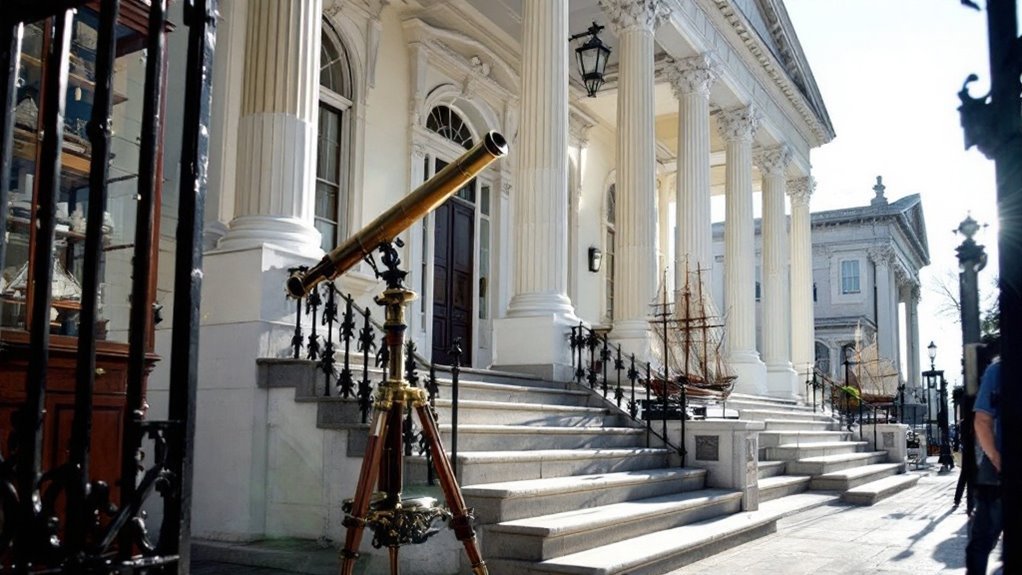Staten Island offers five distinctive museums showcasing the borough’s rich cultural heritage. The Staten Island Museum presents natural science and art collections, while the Noble Maritime Collection celebrates maritime history. Historic Richmond Town provides an immersive colonial experience across 100 acres. The Jacques Marchais Museum features Tibetan art, and the Alice Austen House preserves photography history. Each venue reveals unique aspects of Staten Island’s diverse cultural landscape.
Key Takeaways
- Staten Island Museum at Snug Harbor Cultural Center showcases a diverse collection of natural science, art, and local history exhibits.
- Historic Richmond Town spans 100 acres with original colonial buildings, offering authentic living history experiences of early American life.
- The Jacques Marchais Museum features a specialized collection of Tibetan art and Himalayan artifacts on scenic Lighthouse Hill.
- Alice Austen House Museum preserves the legacy of a pioneering photographer while offering stunning views of New York Harbor.
- The Noble Maritime Collection documents Staten Island’s rich maritime heritage through historical artifacts and nautical artwork.
Where to Find the Best Museums in Staten Island
While Staten Island may be the least populated of New York City’s five boroughs, it offers several notable museums concentrated primarily along its North Shore and Mid-Island regions.
The St. George neighborhood houses the Staten Island Museum at Snug Harbor Cultural Center, showcasing natural science, art, and local history exhibits. Nearby, the Noble Maritime Collection preserves the area’s maritime heritage through artifacts and artwork.
The Snug Harbor Cultural Center enriches Staten Island with its museum’s diverse collections, while maritime history comes alive at Noble Maritime.
The Historic Richmond Town, located in the island’s center, functions as a living history museum spanning 100 acres with original colonial-era buildings.
The Jacques Marchais Museum of Tibetan Art, situated on Lighthouse Hill, features an impressive collection of Himalayan artifacts.
The Alice Austen House Museum on the northeastern shore preserves the legacy of the pioneering female photographer while offering stunning views of New York Harbor.
Essential Tips for Visiting Staten Island Museums
Planning ahead is essential for making the most of Staten Island’s museum visits. Most museums offer reduced admission rates on specific days, and some provide free entry during designated hours. Visitors should check official websites for current operating schedules and special exhibitions.
Public transportation to Staten Island museums is readily available via the Staten Island Ferry and local buses. Those driving should verify parking availability, as some locations have limited spaces. Many museums require advance reservations for guided tours or educational programs.
Visitors should allocate adequate time for each museum, typically 1-2 hours minimum. Photography policies vary by institution, so checking guidelines beforehand is recommended.
During peak tourist seasons, arriving early helps avoid crowds. Most museums offer on-site cafes or are near dining options for convenience.
FAQ
Do Any Staten Island Museums Offer Guided Tours in Languages Besides English?
Through echoing halls and historic corridors, multilingual voices guide visitors in their native tongues.
Several Staten Island museums provide guided tours in Spanish, with the Staten Island Museum and Snug Harbor Cultural Center being the primary institutions offering this service.
While Spanish is the most commonly available alternative language, some special exhibitions and events may feature additional language options upon advance request.
Are There Special Museum Programs or Exhibits Designed for Children With Disabilities?
Museums commonly offer accommodations and specialized programming for children with disabilities.
These typically include sensory-friendly hours, tactile exhibits, wheelchair accessibility, and modified tours for different cognitive and physical needs. Staff members are usually trained to assist visitors with various disabilities.
Many institutions provide social stories and visual schedules to help children prepare for their visit and better navigate the museum environment.
Which Staten Island Museums Allow Photography and Video Recording Inside?
Over 80% of US museums have revised their photo policies in the last decade to be more visitor-friendly.
Most Staten Island museums now allow non-flash photography and video recording for personal use, including the Staten Island Museum and Snug Harbor Cultural Center.
The National Lighthouse Museum permits indoor photography with some exhibit restrictions.
The Jacques Marchais Museum of Tibetan Art requires special permission for any photography or filming.
Do Local Museums Offer Private Event Spaces for Celebrations or Meetings?
Many local museums offer private event spaces that can be rented for celebrations, corporate meetings, and special occasions.
These venues typically provide unique architectural settings, professional event coordination services, and various amenities like catering options and audiovisual equipment.
Museum event spaces can range from intimate galleries to grand halls, accommodating different group sizes and event types while offering culturally rich surroundings.
Can Visitors Donate Historical Artifacts or Artworks to Staten Island Museums?
Museums maintain meticulous methods for managing material donations from the public.
Most institutions welcome potential artifact and artwork contributions but require detailed documentation of the item’s provenance, historical significance, and condition.
Donors must typically complete formal paperwork and schedule an appointment with curators who evaluate pieces for authenticity, relevance to collections, and preservation needs before accepting donations into their permanent holdings.






